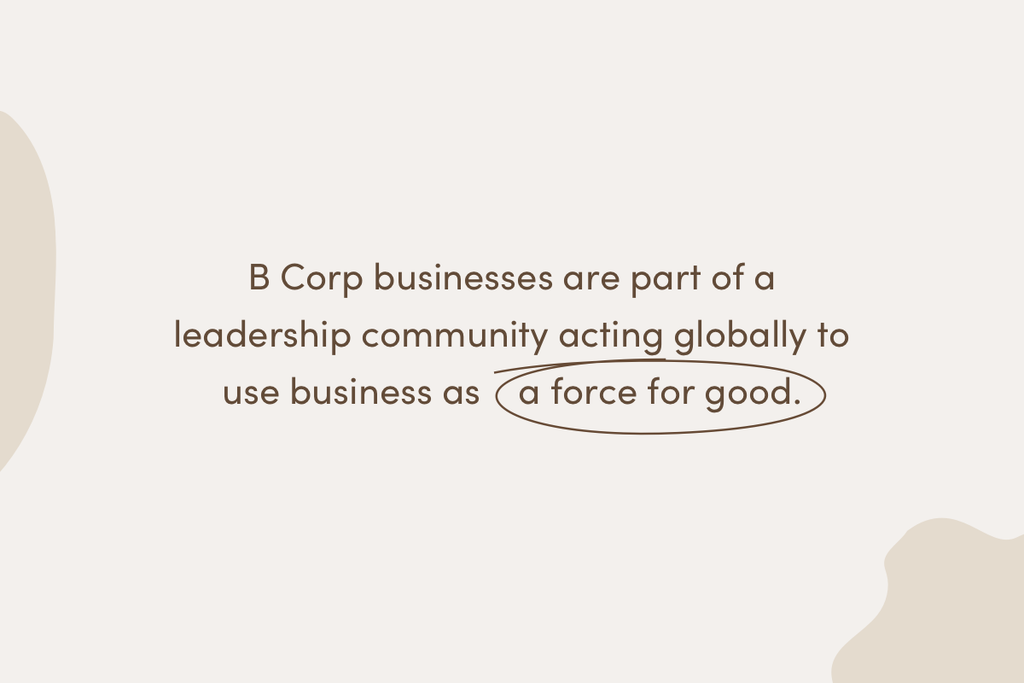
We’re extremely proud and very excited to announce that we’re officially B Corp Certified. In late 2021, we earned our place as part of the global B Corp movement for a more sustainable and inclusive economy. We’re the first underwear brand in the United States to do so. This certification shows we meet the highest standards of social and environmental impact.
It has been a journey
As a brand built on sustainable values, B Corp has always been a constant reminder to do things differently, with people and the planet equally top of mind. It was in late 2019, during the Covid pandemic and at a time when we all started to reflect a little bit more, that we finally took up the task of auditing and documenting everything we do to apply for B Corp certification. Awarded in late 2021, we are so proud to say that we are the first underwear brand in the United States to wear the B Corp badge. Did we think we were going to debut with an impressive score of 101.6? No way, but wow are we proud. In joining the global B Corp community, we solidify our promise to balance purpose and profit and consistently use our business as a force for good.
So, why exactly does this matter and what does it really mean? Keep reading.

What is it?
B Corp is both a global movement and a framework to formalize using business as a force for good balancing people, planet and profit. Certified B Corporations (B Corps) are part of an initiative from B Lab, a non-profit that serves a global movement. For people who want to shop from businesses they believe in, the B Corp logo has fast become a near-universal signpost. The encircled capital ‘B’ is the mark of a brand that believes that business can be used as a force for good. The B Corp certification is globally recognized - we’re so proud to be on this list.
Why a certification?
B Corp certification is awarded to businesses that hold themselves genuinely and transparently accountable, and demonstrate excellence in five key pillars - governance, workers' rights, community, environment and customers. It allows those interested businesses to benchmark themselves against the very best ethical and sustainable peers from all around the world.
Our score
In late 2021, we achieved a first-time score of 101.6. The average B Corp score is 90 while the average score for first-time applicants is 51.

The standards
The process took us a year and was one that involved a lot of hard work and commitment. In order to achieve certification, we had to
- Demonstrate high social and environmental performance by achieving a B Impact Assessment score of 80 or above and passing our risk review. Multinational corporations must also meet baseline requirement standards.
- Make a legal commitment by changing our corporate governance structure to be accountable to all stakeholders, not just shareholders, and achieve benefit corporation status.
- Exhibit transparency by allowing information about our performance measured against B Lab’s standards to be publicly available on their B Corp profile on B Lab’s website
Why does this matter to you?
That little encircled 'B' is a way for customers to instantly recognize that the organizations they buy from are working according to an entirely new way of doing business. This accreditation means that you can trust that we meet the highest standards for positive social and environmental impact.

A never-ending journey
Being B Corp certified isn’t simply a check box for us. It's a journey that's measured every three years which allows us to continuously work towards the highest standards of an independent body.
Thanks so much for being part of the journey - this is really as much of your win as it is ours.
You may also like
Guide
SOCKS SIZE GUIDE
Women's Socks BOODY / EU SIZE FOOT LENGTH (CM) AU / US WOMENS SIZE UK WOMENS SIZE AU / US MENS SIZE UK MENS SIZE 34 - 40 22 - 26 3 - 9 3 - 6 40 - 45 26 - 29 9 - 12 7 - 9 6 - 10 6 - 9 45 - 50 29 - 32 11 - 14 10 - 14 Men's Socks BOODY / EU SIZE FOOT LENGTH (CM) AU / US WOMENS SIZE UK WOMENS SIZE AU / US MENS SIZE UK MENS SIZE 34 - 40 22 - 26 3 - 9 3 - 6 40 - 45 26 - 29 9 - 12 7 - 9 6 - 10 6 - 9 45 - 50 29 - 32 11 - 14 10 - 14 Size Guide

Guide
The Best Father's Day 2023 Gifts...according to Boody
Father’s Day takes place on the third Sunday in June; this year it’s June 18th, 2023. For many of us, buying both a thoughtful and useful gift for our father’s and fatherly figures can typically prove to be a dilemma.

Guide
What to Look for When Buying Activewear
When it comes to what you workout in, it's important to consider how they make you feel and look—but also their impact on the environment. That's where sustainable activewear by Boody comes in.





























